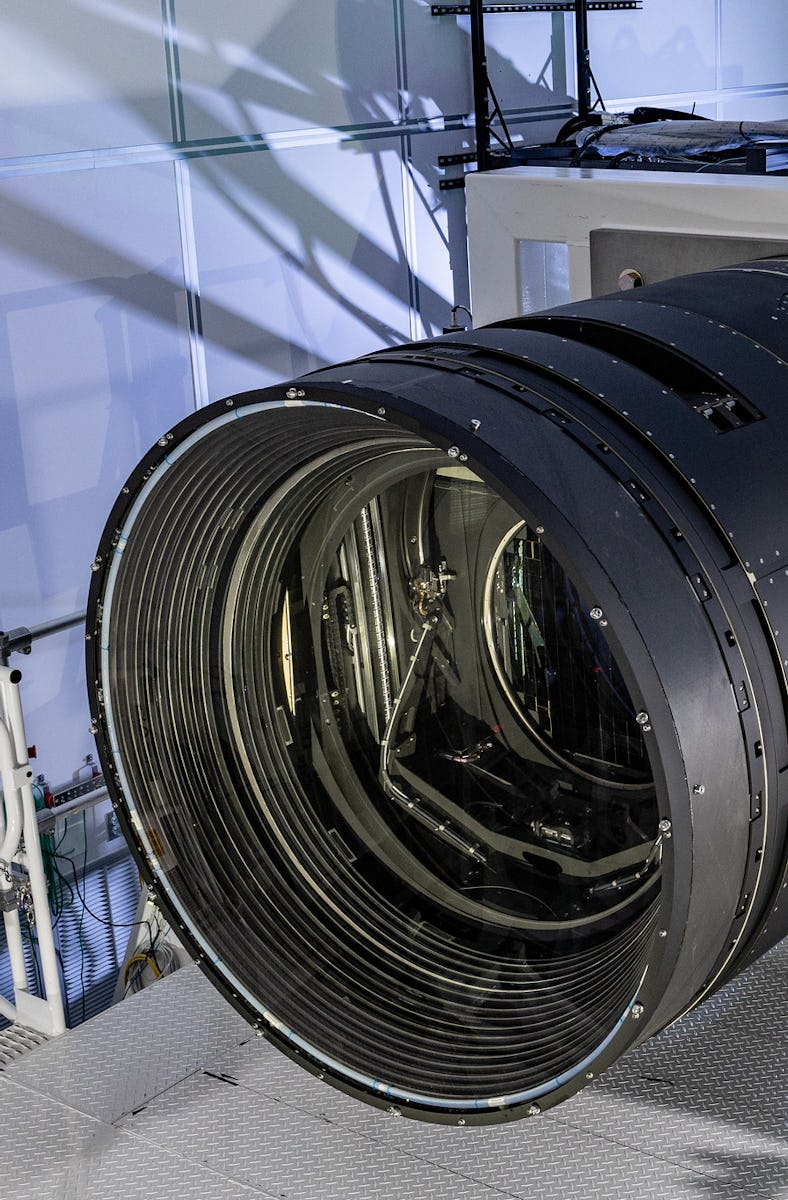This New Telescope Could Create the Greatest Space Movie of All Time
The world’s largest digital camera is epic, from its size to its ambitious movie.

Like the family camcorder, the largest digital camera in the world will capture the next 10 years of cosmic life in memorable detail.
In mid-May, the Legacy Survey of Space and Time (LSST) Digital Camera, now officially called the Vera C. Rubin Observatory, will travel from its current home in California to Cerro Pachón, a mountain in northern Chile.
The camera, the team behind it purports, will take the greatest movie of all time. Observations will begin around January 2025.
Trilogy enthusiasts be warned: to watch all the video clips back to back, each packed with a decade’s worth of observations of just one slice of the southern sky, would take a year. That’s without sleeping, too, Rubin Observatory construction director Željko Ivezić tells Inverse.
Aerial view of Vera C. Rubin Observatory.
The camera will record our celestial family. That includes close cousin asteroids, infrequent visitors like comets, the Sun’s community of stars whizzing around the center of the Milky Way and outside the galaxy, to the far reaches of our celestial family tree. Ivezić is optimistic the LSST Camera will discover five million asteroids, and see about 20 billion stars in our galaxy, plus about 20 billion galaxies.
Imaging the cosmos and how it changes at varying distances will help reveal many dynamics at play. The camera’s work will complement other missions surveying the night sky such as Gaia and Euclid. The science produced can help answer questions about whether or not Albert Einstein had it entirely right with his theory of general relativity, reveal new transient phenomena like supernovas and variable stars, and quintuple the number of known asteroids zipping through the Solar System.
The idea of a massive digital camera isn’t revolutionary. But the technology is. The University of Arizona produced the camera’s most critical component, the three mirrors, for the low price of $30 million. Ivezić says before modern advancements in manufacturing, the mirrors would have cost hundreds of millions of dollars. The camera’s field of view required computers to be capable of storing 3,200 megapixels and processing them. This wasn’t possible until recently.
The LSST Camera, the world's largest digital camera, has its lens cap off in this September 2022 photo.
LSST Camera will hone in on a section of the southern night sky, about 45 times larger than the size of the Full Moon, for 30 seconds. It rapidly repoints to the next 9.6 square degrees slice of space, and repeats. This way, the camera shoots the entire night sky in three nights. To observe the southern sky in its totality in all six color filters of its carousel takes about three weeks. When the round is complete, the camera starts all over again. This will go on and on for ten years.
The repetition increases the exposure time of each segment. This makes the images more sensitive to dimmer objects. The numerous exposures reveal an average appearance. That’s how the team hopes to discover interlopers, like asteroids and comets.
Over more repetitions, the subtle motions of stars relative to the Sun will also become apparent. Star motions are much gnarlier than they seem. “Those motions are actually faster than the motion of Earth around the Sun,” Ivezić says. “The relative speed is actually higher between the stars, but when you look at images, it’s much smaller because they are thousands of times farther away.”
LSST Camera Deputy Project Manager Travis Lange (left) and science and engineering associate Mike Silva (right) inspect the L3 lens in preparation of its installation onto the focal plane of the camera.
Astronomers will use the LSST Camera to measure galaxy traits. Their colors reveal their distances. Distortion to their shapes would hint at gravitational lensing, as extraordinarily massive structures bend light. Their placements would fine-tune ideas about how galaxies distribute over time. The expansion of the universe may also get less mysterious.
The SUV-sized camera will soon begin a daunting journey. The Boeing 747 that will fly it across the Americas can land in La Serena, Chile. But it cannot take off from this small airport. So the big plane will have to land farther from the observatory site, in Santiago. A truck carrying the camera will sojourn out of the capital into the Andean highlands. Once it reaches the road that leads up to the 8,900-foot-high summit of Cerro Pachón, it won’t go more than a few miles an hour.
To say the cargo is precious is putting it mildly. It’s covered by insurance, but the team never wants to have to cash in. “They would get money back, but there is no place to go to buy a new camera,” Ivezić says.